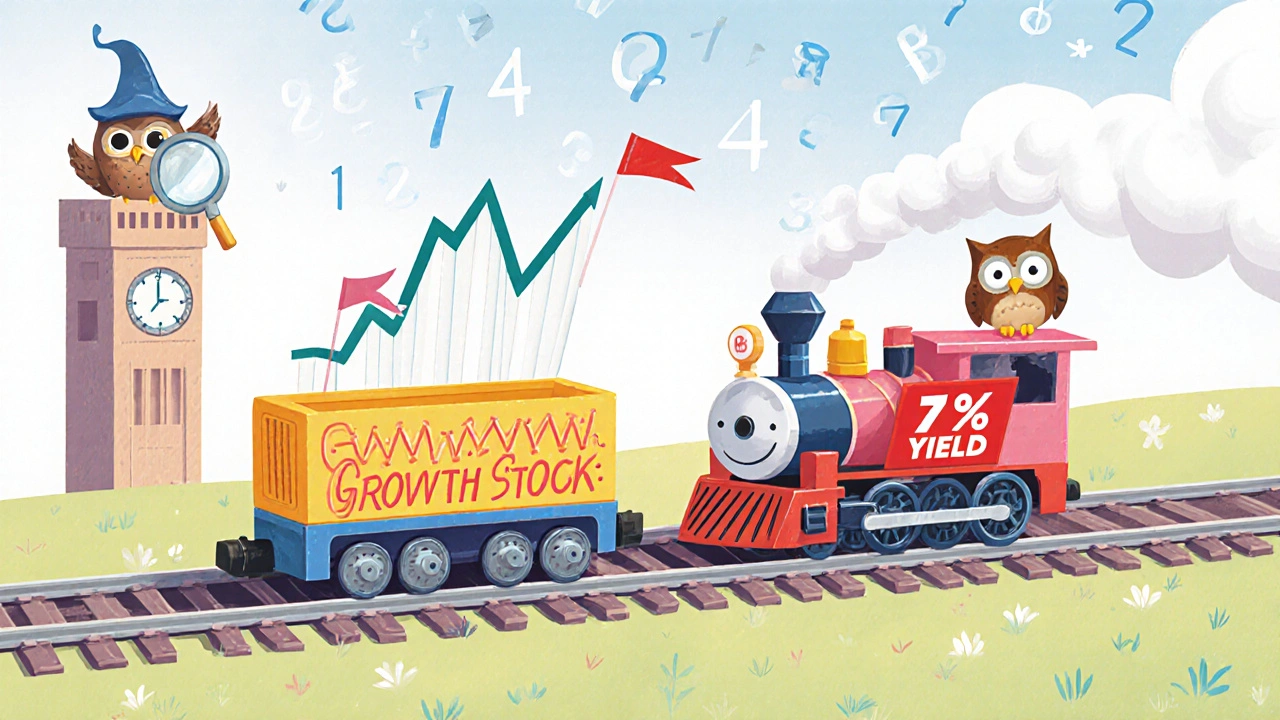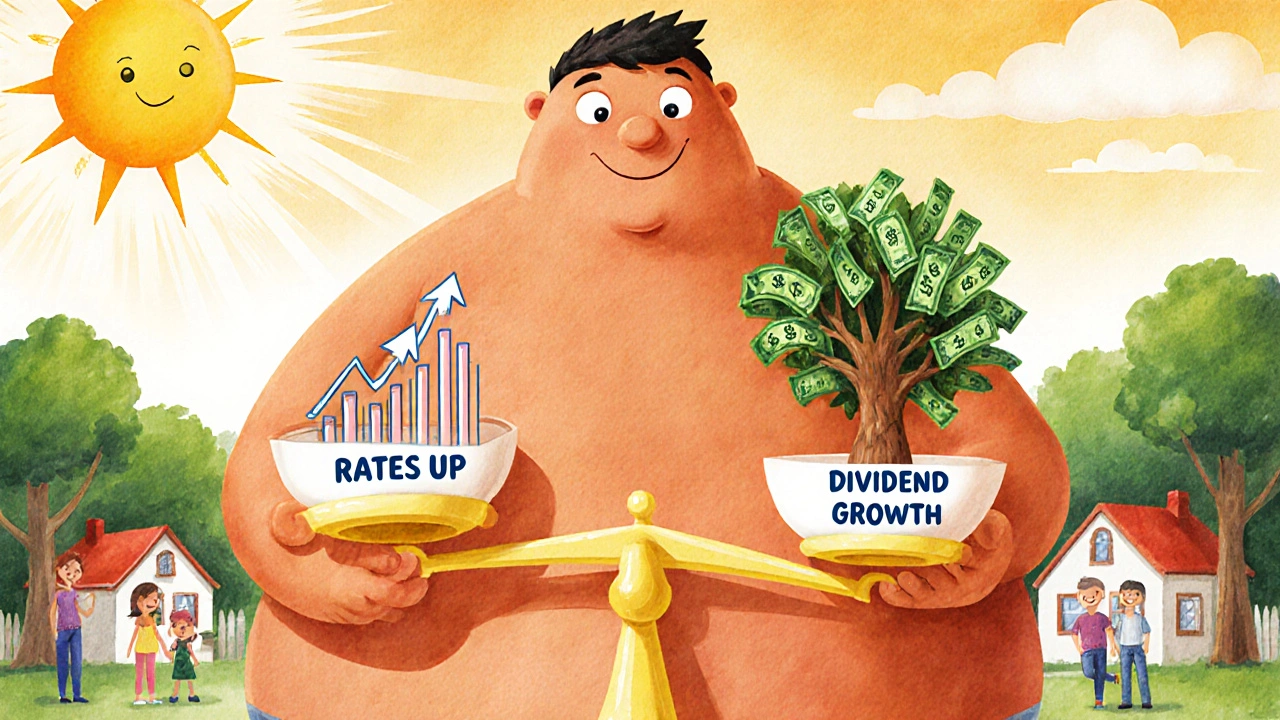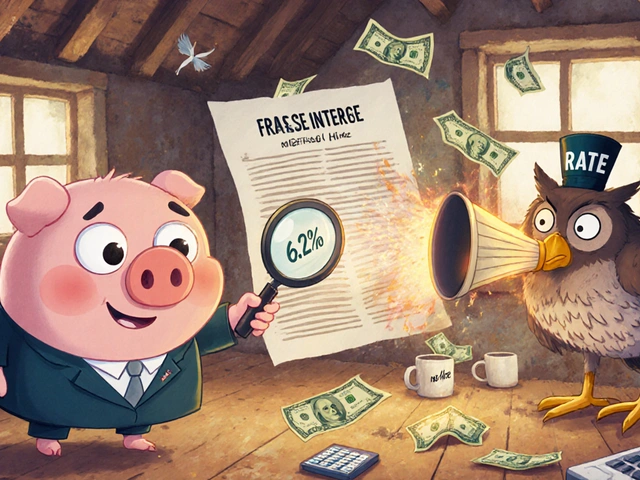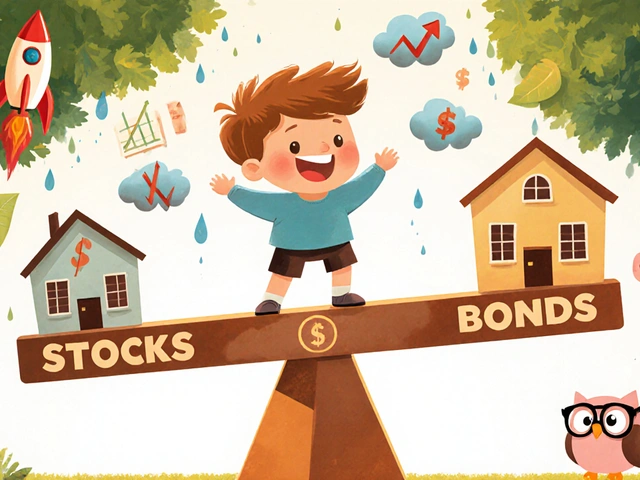Dividend Stock Valuation Calculator
This calculator shows how changing interest rates affect the present value of dividend stocks with different growth characteristics. See how dividend growth stocks outperform high-yield stocks during rate hikes.
When interest rates rise, you’ve probably heard that dividend stocks get hit. But is that really true? Or is it just a myth that keeps getting repeated? The truth is more complicated-and far more useful-if you know what to look for.
Why Interest Rates Change Stock Prices
At its core, a stock’s value is based on the money it’s expected to pay you in the future. For dividend stocks, that means the cash you’ll get from dividends, year after year. To figure out what that’s worth today, investors use something called the discounted cash flow model. It takes all those future payouts and shrinks them back to today’s value using a discount rate. That rate? It’s often tied to interest rates. When interest rates go up, that discount rate goes up too. Higher discount rate = smaller present value. So yes, mathematically, rising rates can make dividend stocks look less valuable. But here’s the catch: interest rates don’t move in a vacuum. They move because something else is changing-like inflation, growth, or fear.The Myth of the Inverse Relationship
Most people think: rates up → stocks down. But that’s not what the data shows. In fact, Wilmington Trust found that when the 10-year Treasury yield rises, the S&P 500’s price-to-earnings ratio often goes up too. Why? Because rising rates usually come with stronger economic growth. Companies earn more. Their dividends grow faster. That extra cash flow more than makes up for the higher discount rate. Think of it this way: if rates rise because the economy is booming, companies are making more money. Their dividends go up. That’s good for your portfolio. But if rates rise because inflation is spiraling and growth is dying-that’s bad. The discount rate goes up, but so do risks. Earnings stall. Dividends get cut. That’s when dividend stocks suffer. The direction of rates doesn’t matter as much as why they’re moving.Dividend Growth vs. High Yield: Two Different Animals
Not all dividend stocks react the same way. There’s a big difference between a company that pays a 5% yield but hasn’t raised its dividend in 10 years-and one that’s raised it every year for 25 years. Companies with long histories of dividend growth-like Coca-Cola, Johnson & Johnson, or Procter & Gamble-have cash flows that stretch far into the future. That makes them sensitive to interest rate changes. When rates rise, the value of those distant payouts drops sharply. These are high-duration stocks. On the other hand, utilities, telecoms, or REITs that pay high yields but rarely grow them? Their cash flows are more front-loaded. Most of the value comes from dividends you’ll get in the next 2-5 years. That makes them less sensitive to rate swings. They’re low-duration stocks. A 2021 analysis by Lyn Alden showed that when the discount rate fell from 12% to 8%, a growth stock’s valuation jumped 61.8%. A value stock with near-term payouts? Only 44.7%. The gap? It’s all about timing. The further out the cash flows, the more they’re affected by rate changes.
Dividend Growth Beats High Yield-Even When Rates Rise
Here’s the counterintuitive part: dividend growers often outperform during rate hikes. Between December 2015 and December 2018, the Federal Reserve raised rates from 0.25% to 2.5%. During that time, the S&P 500 Dividend Aristocrats Index-companies with 25+ years of rising dividends-returned 46.3%. The broader S&P 500? Just 35.7%. Why? Because these companies kept raising dividends. Their payouts grew faster than inflation. Their earnings kept climbing. Investors didn’t just get income-they got income that kept getting bigger. ProShares looked at Q1 2021, when the 10-year Treasury yield jumped from 0.93% to 1.74%. In that same quarter, 124 S&P 500 companies raised dividends. Only 3 cut them. The dividend raisers returned 10.24%. The cutters? Down 3.26%. That’s a 13.5 percentage point gap in just three months. High yield looks tempting when rates are low. But growth is what protects you when rates rise.Yield-on-Cost: The Silent Powerhouse
Here’s a simple trick most investors ignore: yield-on-cost. It’s not the current yield. It’s what you’re earning on your original investment. If you bought a stock for $50 that paid $2 in dividends, your yield-on-cost is 4%. If that company raises its dividend to $4 after 10 years, your yield-on-cost is now 8%-even if the stock price doubled to $100. Lord Abbett compared a $10,000 investment in the S&P 500 versus U.S. bonds. Bonds started with higher income. But over 20 years, the S&P 500’s dividend income outgrew the bond payments. Why? Because companies keep raising dividends. Bonds don’t. In a rising rate environment, that compounding effect is your best defense. A stock that raises its dividend 7% a year will double its payout in about 10 years. That’s not just income. That’s inflation protection.What Kind of Rate Shock Are You Facing?
Not all rate changes are created equal. A 2025 paper by Gormsen and Lazarus found that only about 35% of rate changes come from “pure discounting”-meaning, the market is just raising the cost of money. The rest come from changes in growth expectations or risk. If rates fall because the economy is slowing? That’s bad for stocks, even if it feels like a relief. If rates rise because companies are earning more? That’s good. If rates rise because inflation is out of control and companies can’t pass on costs? That’s terrible. The key isn’t the rate level. It’s the story behind it.
What Should You Do Right Now?
Forget trying to time interest rates. You can’t predict them. But you can build a portfolio that handles them.- Focus on companies with 10+ years of consistent dividend growth. Look for earnings growth that supports the payout.
- Avoid chasing the highest yield. A 7% yield from a company cutting dividends is a trap.
- Hold dividend growers across market caps. Small-cap growers often outperform in rising rate environments.
- Use yield-on-cost as your performance metric-not current yield.
- Don’t panic when rates rise. Check if earnings are rising too.
Dividend Stocks in 2025: The Real Story
As of late 2025, interest rates are still elevated compared to the 2010s. But the market isn’t collapsing. Why? Because corporate profits are holding up. Inflation is cooling. Companies are still raising dividends. The S&P 500 Dividend Aristocrats Index still trades at a slight premium to the broader market-not because it’s overvalued, but because investors know these companies deliver through cycles. They don’t just pay dividends. They grow them. And that’s what matters. If you’re holding dividend stocks right now, ask yourself: Is this company earning more? Are they raising their payout? Are they investing in their future? If yes, then interest rates are just background noise.Final Thought: It’s Not About Rates. It’s About Cash Flow.
Interest rates are just one input. The real driver of dividend stock value is the quality and growth of the cash flow behind the dividend. A company that grows its earnings and dividends every year-even in a high-rate world-will find buyers. A company that pays a big yield but has no growth, no pricing power, and declining profits? It doesn’t matter if rates are 1% or 6%. That stock will struggle. Stop worrying about what the Fed does. Start watching what your companies do.Do rising interest rates always hurt dividend stocks?
No. Rising rates often come with stronger economic growth, which boosts corporate earnings and dividend payouts. Historically, dividend growers have outperformed during rate hikes, especially when the rate increases reflect improving business conditions rather than inflation or recession fears.
Are high-yield dividend stocks safer than growth dividend stocks?
Not necessarily. High-yield stocks often come from mature companies with limited growth. If their earnings stall, dividends can be cut. Growth dividend stocks, while more sensitive to interest rates, tend to be more resilient over time because their payouts rise with earnings. The best dividend portfolios combine both, but prioritize consistent growth over current yield.
What’s the difference between duration in dividend stocks and bonds?
Bond duration measures sensitivity to interest rate changes based on maturity and coupon payments. In dividend stocks, duration refers to how far into the future the majority of expected cash flows occur. Growth stocks have long duration because most of their value comes from dividends 10+ years out. Value stocks have short duration because their payouts are more immediate. Long-duration stocks fall more when rates rise.
Should I sell my dividend stocks if rates keep rising?
Only if the company’s fundamentals are weakening. If earnings and dividends are still growing, rising rates alone aren’t a reason to sell. In fact, many dividend growers have outperformed during past rate-hiking cycles. Focus on the quality of the business, not the direction of rates.
How does yield-on-cost help in a rising rate environment?
Yield-on-cost measures your personal return based on your original purchase price. Even if the stock’s current yield drops because the price rose, your yield-on-cost keeps climbing if the company raises dividends. Over time, this can turn a modest yield into a powerful income stream that outpaces inflation and bond yields.
What’s the best dividend strategy for today’s interest rate environment?
Focus on companies with 10+ years of dividend growth, strong balance sheets, and pricing power. Avoid chasing the highest current yield. Look for businesses that can raise prices and profits even when inflation or rates are high. Reinvest dividends to compound your returns. This strategy works across all rate environments.




Okay but let’s be real-everyone’s freaking out about rates like it’s 2008, but if your dividend stock’s earnings are climbing and the payout’s growing? Rates are just background static. I’ve been holding JNJ since 2020 and my yield-on-cost is now 5.8%. Current yield? Like 2.1%. Who cares? I’m getting paid to wait.
And don’t even get me started on those ‘high yield’ traps. 7%? Cool. Until the dividend gets cut and you’re stuck with a $30 stock that used to be $80. Growth over yield, always.
Utterly disingenuous to suggest that rising rates don’t hurt dividend valuations-mathematically, they do. The DCF model doesn’t lie. What’s being conflated here is correlation with causation. Yes, rate hikes often coincide with growth-but that’s not because the rate increase *caused* growth. It’s because the Fed is reacting to it.
When the 10Y hits 5%, even Coca-Cola’s 25-year growth streak doesn’t magically offset the discounting of cash flows 20 years out. The data cherry-picked here ignores the 2022-2023 period, where dividend aristocrats underperformed the S&P 500 by 11%. Don’t confuse survivorship bias with strategy.
Bro, the whole ‘it’s not the rate, it’s the why’ thing is 100% correct. I’ve been saying this for years. People act like the Fed’s a magic wand that turns stocks into dust when it ticks up a quarter point.
But if you’re holding a company that can raise prices because consumers still need their stuff-like P&G or MMM-you’re fine. The real danger? Buying a REIT because it pays 6% and has ‘stable cash flows.’ Meanwhile, the tenant base is crumbling and the debt’s coming due in 2026. That’s not investing. That’s gambling with dividends.
Yield-on-cost is the only metric that matters after five years. My first buy in 2018? 3.2%. Now? 8.9%. That’s compounding. That’s power. That’s how you win.
Dear friends, I have been contemplating this matter deeply, for I have witnessed the cycles of markets with the patience of a monk and the curiosity of a child. When interest rates rise, it is not merely a financial adjustment-it is a reflection of the soul of the economy. Is it fear that drives the rate higher? Or is it the quiet confidence of corporations that dare to grow, to innovate, to pay their workers more, to invest in the future?
Those who see only the discount rate are blind to the human story behind the numbers. A dividend is not a number on a screen-it is the echo of a CEO’s decision to share prosperity. A company that raises its dividend annually, year after year, even when the world trembles, is not merely a stock-it is a covenant.
And so, when I look at my portfolio, I do not ask whether the Fed will hike again. I ask: Has this company earned its dividend? Has it honored its promise? If yes, then let the rates rise. Let them rise like the tide. I shall still be here, collecting my growing harvest, quietly, patiently, gratefully.
Forgive my long words, but in a world of algorithms, I choose to remember: finance is not math. It is morality made visible.
With warmth and hope,
Astha